roof rack JEEP PATRIOT 2007 1.G Owners Manual
[x] Cancel search | Manufacturer: JEEP, Model Year: 2007, Model line: PATRIOT, Model: JEEP PATRIOT 2007 1.GPages: 440, PDF Size: 7.26 MB
Page 52 of 440
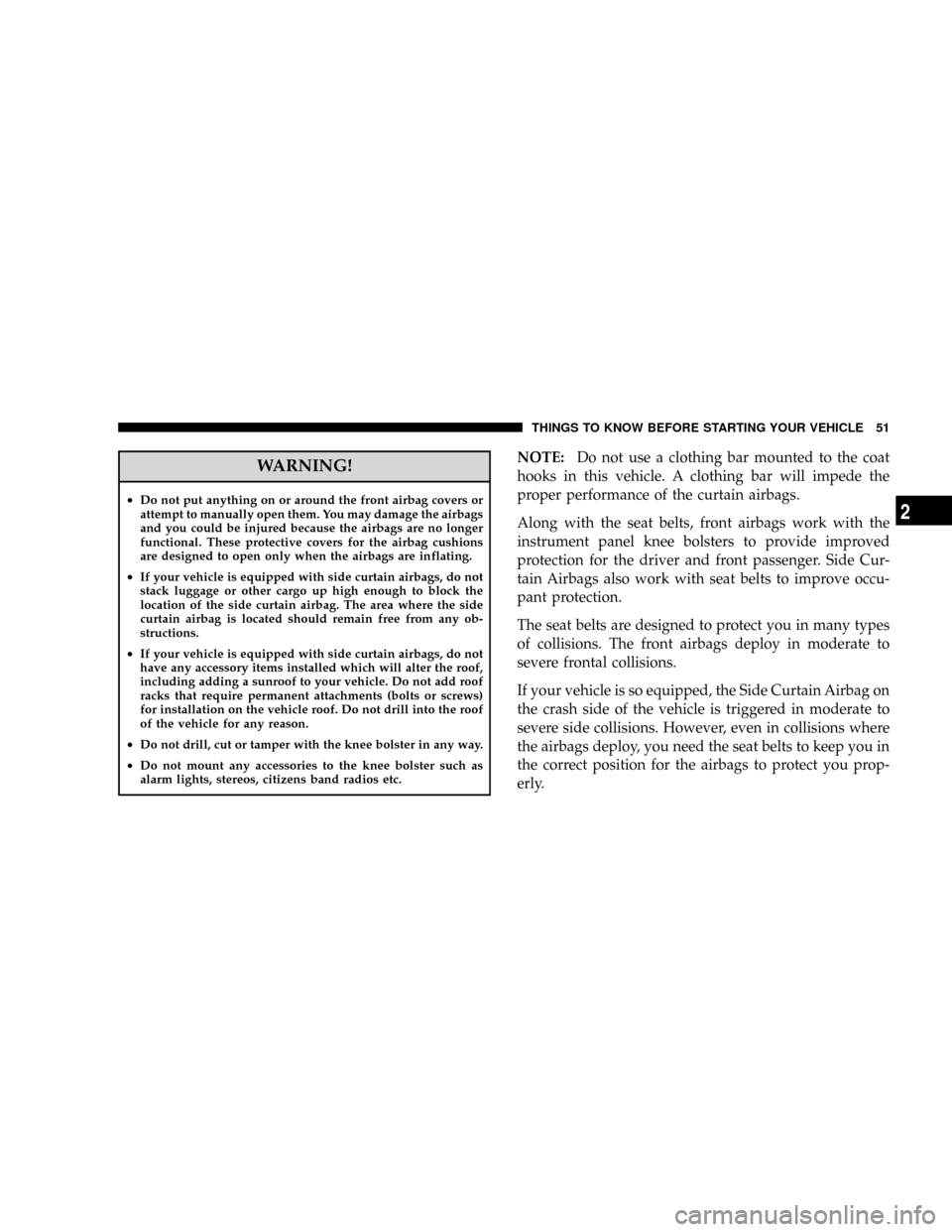
WARNING!
²Do not put anything on or around the front airbag covers or
attempt to manually open them. You may damage the airbags
and you could be injured because the airbags are no longer
functional. These protective covers for the airbag cushions
are designed to open only when the airbags are inflating.
²If your vehicle is equipped with side curtain airbags, do not
stack luggage or other cargo up high enough to block the
location of the side curtain airbag. The area where the side
curtain airbag is located should remain free from any ob-
structions.
²If your vehicle is equipped with side curtain airbags, do not
have any accessory items installed which will alter the roof,
including adding a sunroof to your vehicle. Do not add roof
racks that require permanent attachments (bolts or screws)
for installation on the vehicle roof. Do not drill into the roof
of the vehicle for any reason.
²Do not drill, cut or tamper with the knee bolster in any way.
²Do not mount any accessories to the knee bolster such as
alarm lights, stereos, citizens band radios etc.
NOTE:Do not use a clothing bar mounted to the coat
hooks in this vehicle. A clothing bar will impede the
proper performance of the curtain airbags.
Along with the seat belts, front airbags work with the
instrument panel knee bolsters to provide improved
protection for the driver and front passenger. Side Cur-
tain Airbags also work with seat belts to improve occu-
pant protection.
The seat belts are designed to protect you in many types
of collisions. The front airbags deploy in moderate to
severe frontal collisions.
If your vehicle is so equipped, the Side Curtain Airbag on
the crash side of the vehicle is triggered in moderate to
severe side collisions. However, even in collisions where
the airbags deploy, you need the seat belts to keep you in
the correct position for the airbags to protect you prop-
erly.
THINGS TO KNOW BEFORE STARTING YOUR VEHICLE 51
2
Page 78 of 440
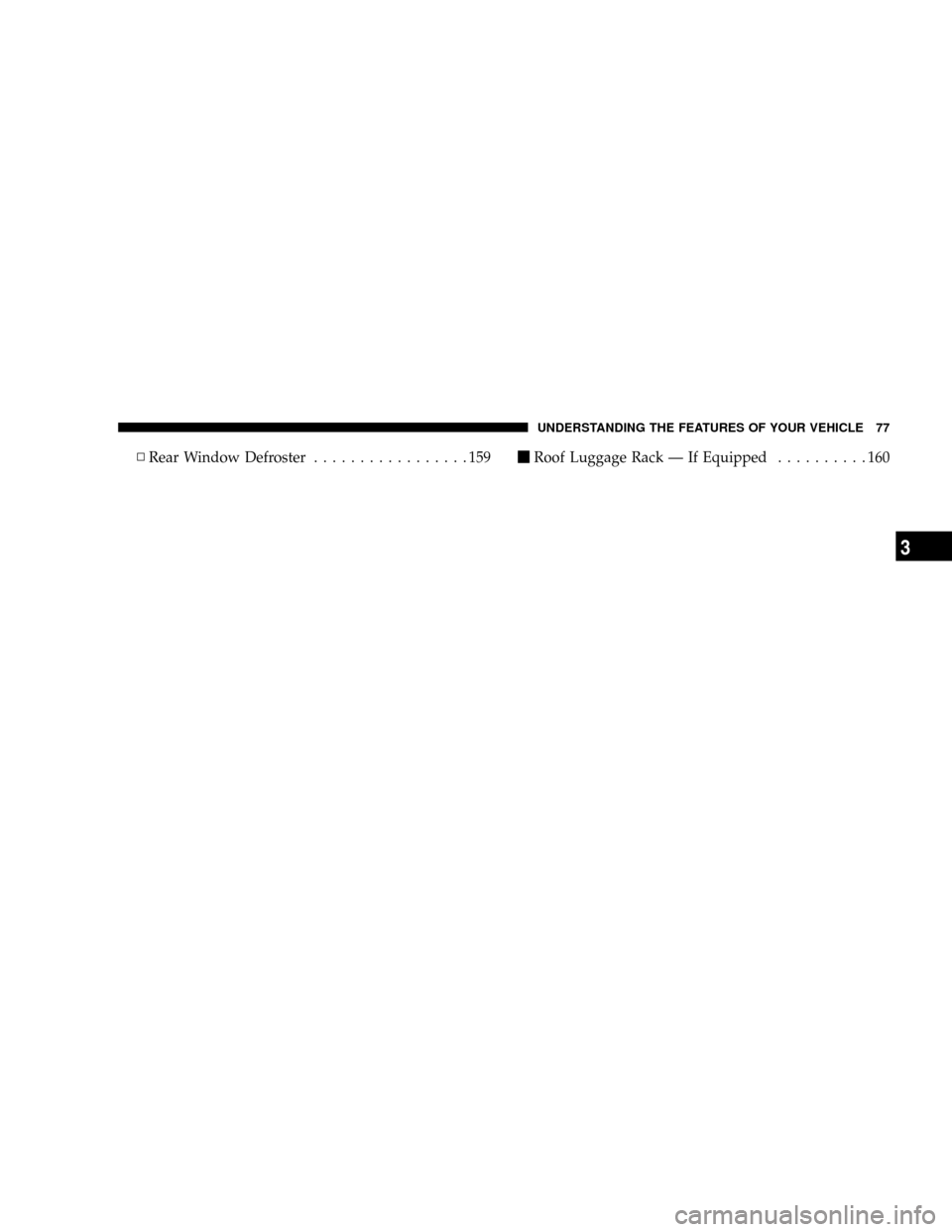
NRear Window Defroster.................159mRoof Luggage Rack Ð If Equipped..........160
UNDERSTANDING THE FEATURES OF YOUR VEHICLE 77
3
Page 161 of 440
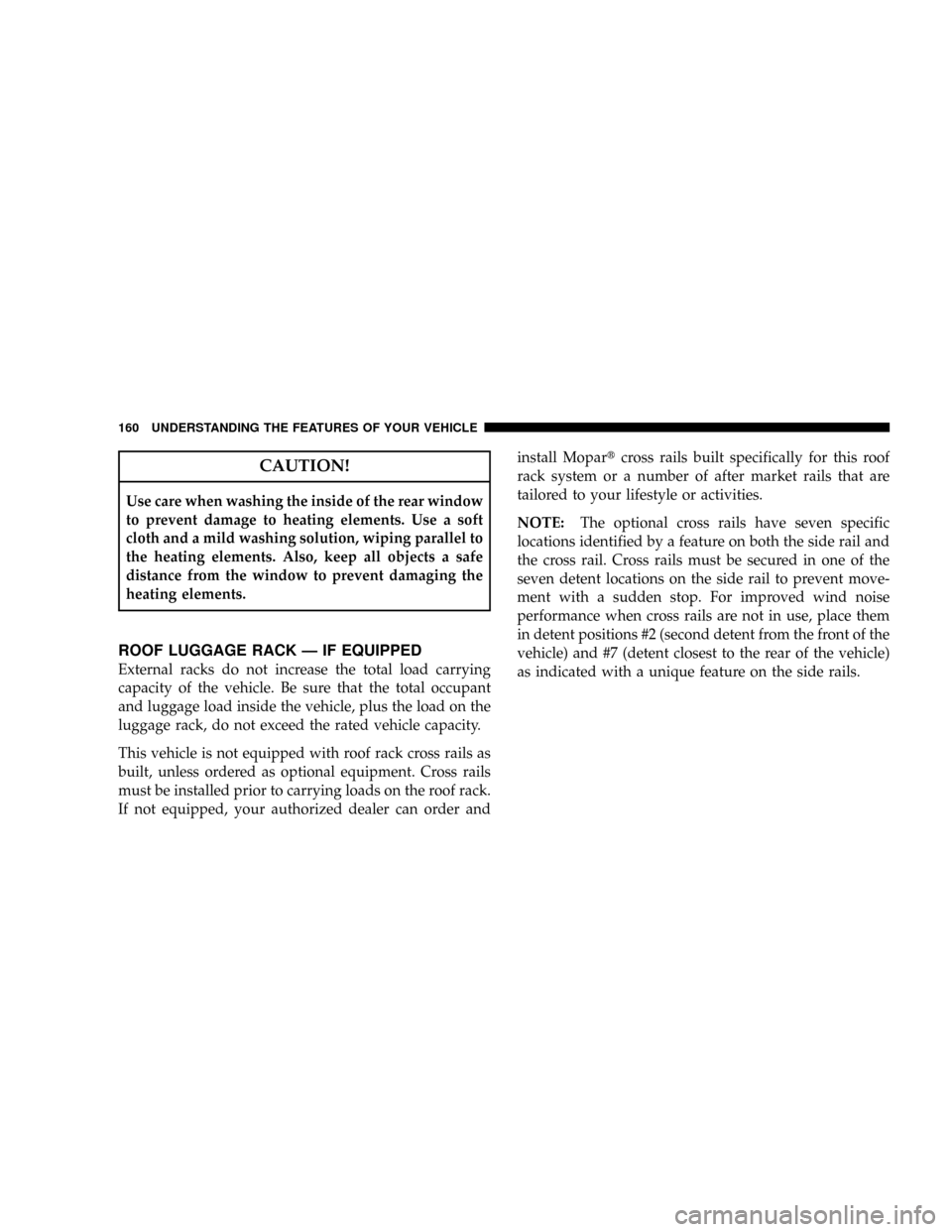
CAUTION!
Use care when washing the inside of the rear window
to prevent damage to heating elements. Use a soft
cloth and a mild washing solution, wiping parallel to
the heating elements. Also, keep all objects a safe
distance from the window to prevent damaging the
heating elements.
ROOF LUGGAGE RACK Ð IF EQUIPPED
External racks do not increase the total load carrying
capacity of the vehicle. Be sure that the total occupant
and luggage load inside the vehicle, plus the load on the
luggage rack, do not exceed the rated vehicle capacity.
This vehicle is not equipped with roof rack cross rails as
built, unless ordered as optional equipment. Cross rails
must be installed prior to carrying loads on the roof rack.
If not equipped, your authorized dealer can order andinstall Mopartcross rails built specifically for this roof
rack system or a number of after market rails that are
tailored to your lifestyle or activities.
NOTE:The optional cross rails have seven specific
locations identified by a feature on both the side rail and
the cross rail. Cross rails must be secured in one of the
seven detent locations on the side rail to prevent move-
ment with a sudden stop. For improved wind noise
performance when cross rails are not in use, place them
in detent positions #2 (second detent from the front of the
vehicle) and #7 (detent closest to the rear of the vehicle)
as indicated with a unique feature on the side rails.
160 UNDERSTANDING THE FEATURES OF YOUR VEHICLE
Page 162 of 440
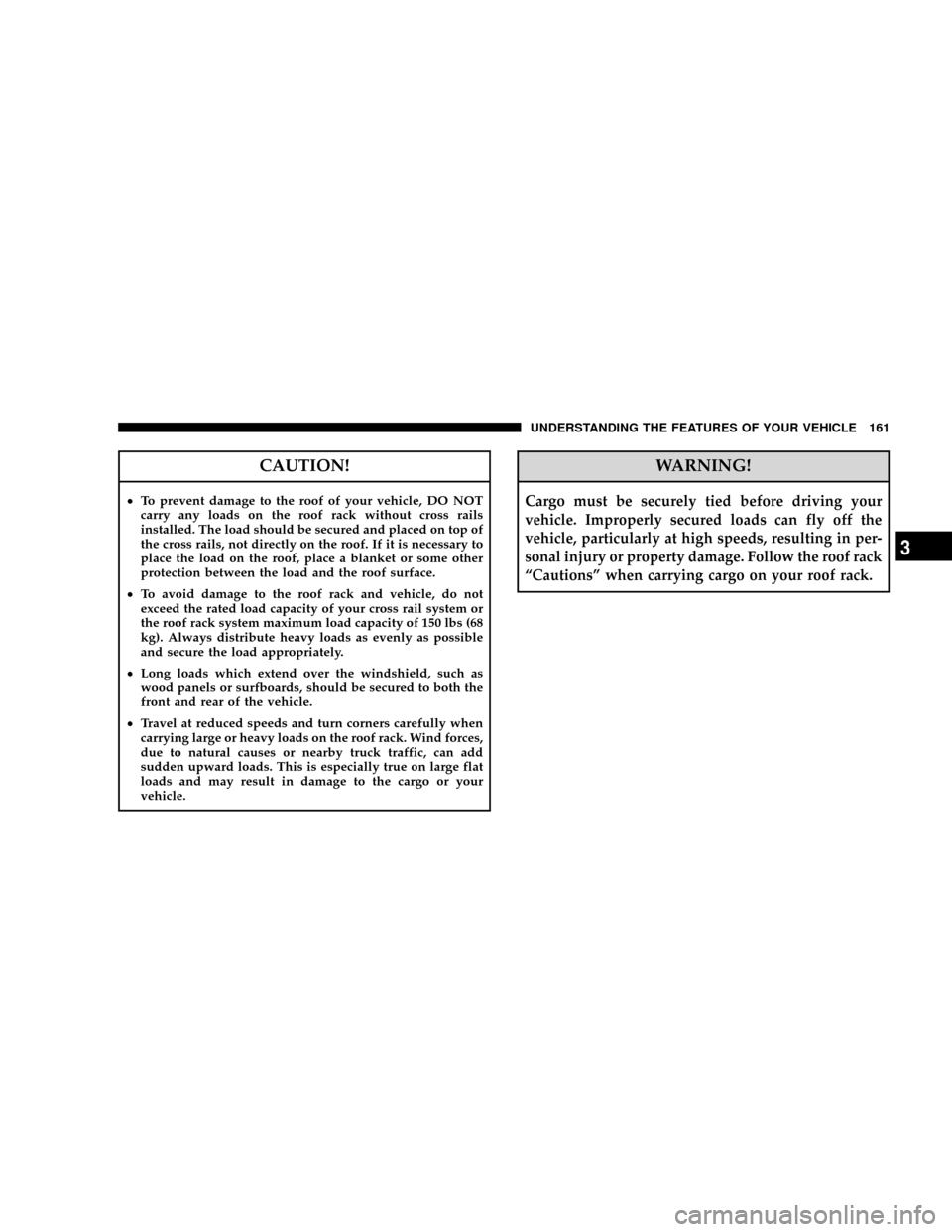
CAUTION!
²To prevent damage to the roof of your vehicle, DO NOT
carry any loads on the roof rack without cross rails
installed. The load should be secured and placed on top of
the cross rails, not directly on the roof. If it is necessary to
place the load on the roof, place a blanket or some other
protection between the load and the roof surface.
²To avoid damage to the roof rack and vehicle, do not
exceed the rated load capacity of your cross rail system or
the roof rack system maximum load capacity of 150 lbs (68
kg). Always distribute heavy loads as evenly as possible
and secure the load appropriately.
²Long loads which extend over the windshield, such as
wood panels or surfboards, should be secured to both the
front and rear of the vehicle.
²Travel at reduced speeds and turn corners carefully when
carrying large or heavy loads on the roof rack. Wind forces,
due to natural causes or nearby truck traffic, can add
sudden upward loads. This is especially true on large flat
loads and may result in damage to the cargo or your
vehicle.
WARNING!
Cargo must be securely tied before driving your
vehicle. Improperly secured loads can fly off the
vehicle, particularly at high speeds, resulting in per-
sonal injury or property damage. Follow the roof rack
ªCautionsº when carrying cargo on your roof rack.
UNDERSTANDING THE FEATURES OF YOUR VEHICLE 161
3
Page 221 of 440
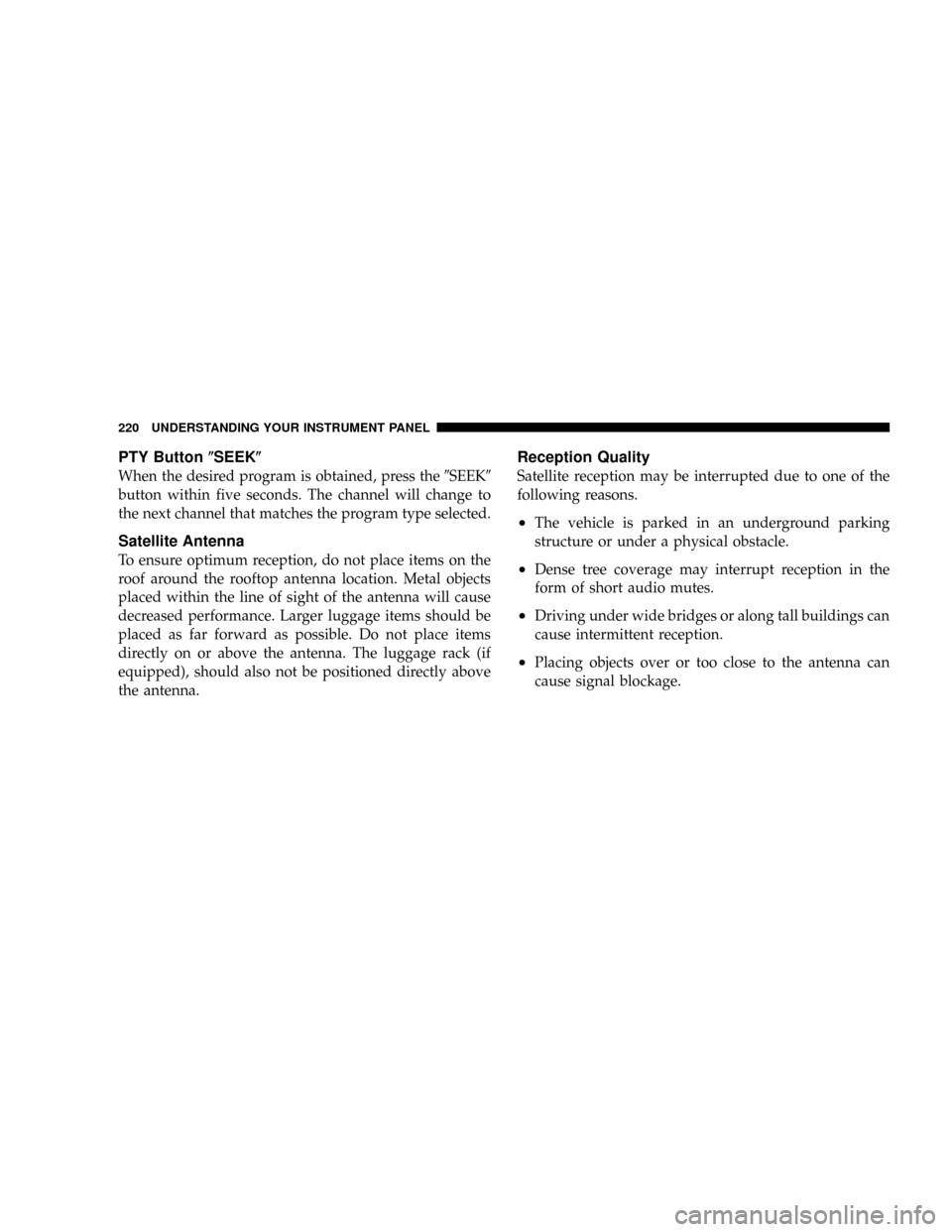
PTY Button(SEEK(
When the desired program is obtained, press the9SEEK9
button within five seconds. The channel will change to
the next channel that matches the program type selected.
Satellite Antenna
To ensure optimum reception, do not place items on the
roof around the rooftop antenna location. Metal objects
placed within the line of sight of the antenna will cause
decreased performance. Larger luggage items should be
placed as far forward as possible. Do not place items
directly on or above the antenna. The luggage rack (if
equipped), should also not be positioned directly above
the antenna.
Reception Quality
Satellite reception may be interrupted due to one of the
following reasons.
²The vehicle is parked in an underground parking
structure or under a physical obstacle.
²Dense tree coverage may interrupt reception in the
form of short audio mutes.
²Driving under wide bridges or along tall buildings can
cause intermittent reception.
²Placing objects over or too close to the antenna can
cause signal blockage.
220 UNDERSTANDING YOUR INSTRUMENT PANEL
Page 431 of 440
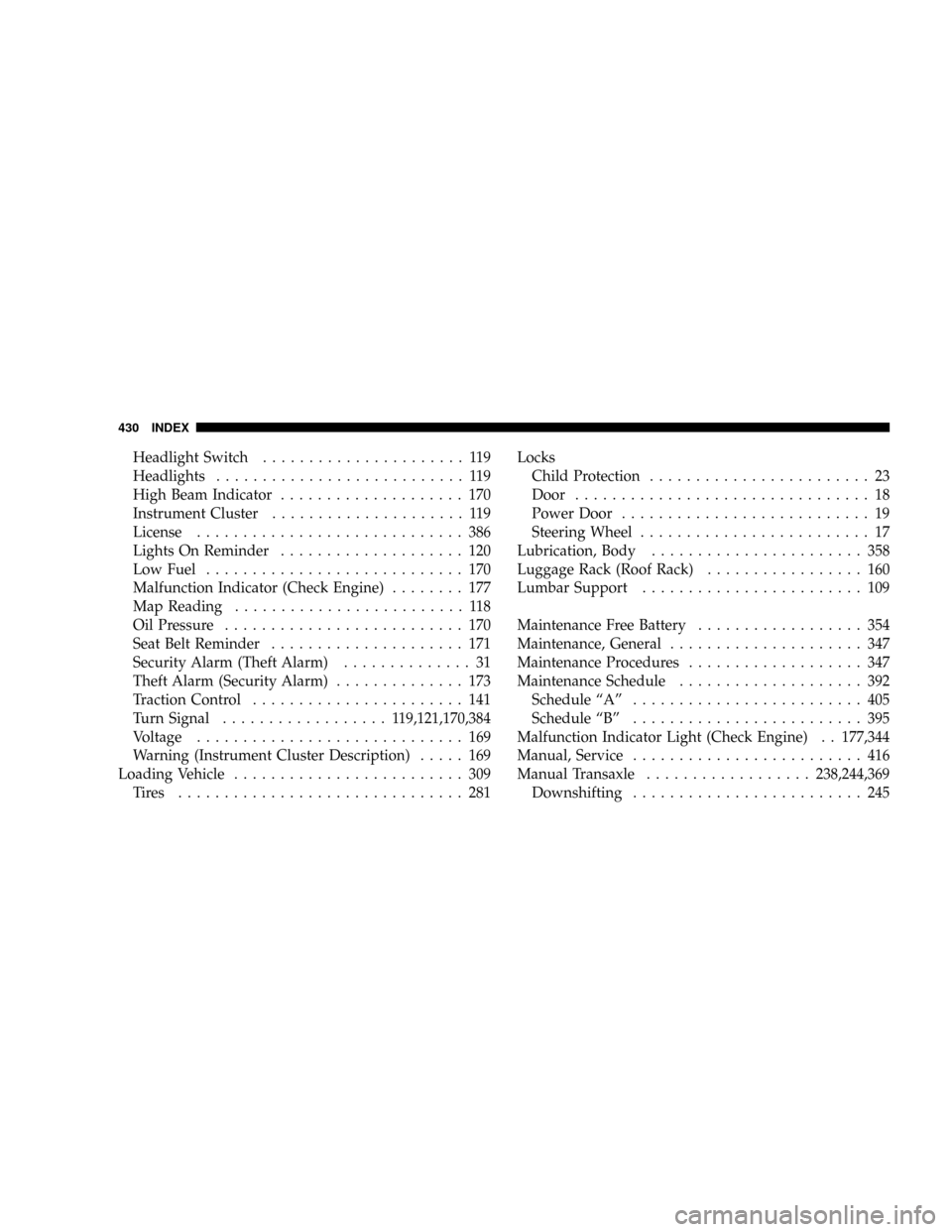
Headlight Switch...................... 119
Headlights........................... 119
High Beam Indicator.................... 170
Instrument Cluster..................... 119
License............................. 386
Lights On Reminder.................... 120
Low Fuel............................ 170
Malfunction Indicator (Check Engine)........ 177
Map Reading......................... 118
Oil Pressure.......................... 170
Seat Belt Reminder..................... 171
Security Alarm (Theft Alarm).............. 31
Theft Alarm (Security Alarm).............. 173
Traction Control....................... 141
Turn Signal.................. 119,121,170,384
Voltage............................. 169
Warning (Instrument Cluster Description)..... 169
Loading Vehicle......................... 309
Tires ............................... 281Locks
Child Protection........................ 23
Door................................ 18
Power Door........................... 19
Steering Wheel......................... 17
Lubrication, Body....................... 358
Luggage Rack (Roof Rack)................. 160
Lumbar Support........................ 109
Maintenance Free Battery.................. 354
Maintenance, General..................... 347
Maintenance Procedures................... 347
Maintenance Schedule.................... 392
Schedule ªAº......................... 405
Schedule ªBº......................... 395
Malfunction Indicator Light (Check Engine) . . 177,344
Manual, Service......................... 416
Manual Transaxle..................238,244,369
Downshifting......................... 245
430 INDEX